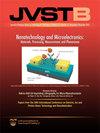Pneumatic controlled nanosieve for efficient capture and release of nanoparticles
IF 1.4
4区 工程技术
引用次数: 0
Abstract
A pneumatic controlled nanosieve device is demonstrated for the efficient capture and release of 15 nm quantum dots. This device consists of a 200 nm deep glass channel and a polydimethylsiloxane-based pneumatic pressure layer to enhance target capture. The fluid motion inside the nanosieve is studied by computational fluidic dynamics (CFD) and microfluidic experiments, enabling efficient target capture with a flow rate as high as 100 μl/min. In addition, microgrooves are fabricated inside the nanosieve to create low flow rate regions, which further improves the target capture efficiency. A velocity contour plot is constructed with CFD, revealing that the flow rate is the lowest at the top and bottom of the microgrooves. This phenomenon is supported by the observed nanoparticle clusters surrounding the microgrooves. By changing the morphology and pneumatic pressure, this device will also facilitate rapid capture and release of various biomolecules.气动控制纳米筛有效捕获和释放纳米颗粒
介绍了一种气动控制的纳米筛装置,用于15nm量子点的高效捕获和释放。该装置由一个200 nm深的玻璃通道和一个基于聚二甲基硅氧烷的气动压力层组成,以增强目标捕获。通过计算流体动力学(CFD)和微流体实验研究了纳米筛内部的流体运动,实现了流速高达100 μl/min的高效目标捕获。此外,在纳米筛内部制造微槽,形成低流速区域,进一步提高了目标捕获效率。利用CFD构建了速度等值线图,发现微槽顶部和底部的流量最低。这一现象得到了微沟槽周围纳米颗粒团簇的支持。通过改变形态和气压,该装置还将促进各种生物分子的快速捕获和释放。
本文章由计算机程序翻译,如有差异,请以英文原文为准。
求助全文
约1分钟内获得全文
求助全文
来源期刊

Journal of Vacuum Science & Technology B
工程技术-工程:电子与电气
自引率
14.30%
发文量
0
审稿时长
2.5 months
期刊介绍:
Journal of Vacuum Science & Technology B emphasizes processing, measurement and phenomena associated with micrometer and nanometer structures and devices. Processing may include vacuum processing, plasma processing and microlithography among others, while measurement refers to a wide range of materials and device characterization methods for understanding the physics and chemistry of submicron and nanometer structures and devices.
 求助内容:
求助内容: 应助结果提醒方式:
应助结果提醒方式:


